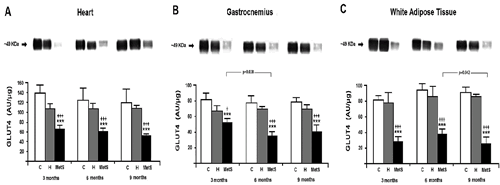ICEECE2012 Poster Presentations Obesity (114 abstracts)
Time-course of changes of GLUT4 expression in insulin-sensitive tissues in an animal model of metabolic syndrome
A. Lehnen 1 , N. Leguisamo 1 , J. Borges 1 , U. Machado 2 , M. Okamoto 2 , M. Markoski 1 , G. Pinto 1 , L. Meurer 3 & B. Schaan 1,
1Instituto de Cardiologia do Rio Grando Sul/Fundação Universitária de Cardiologia, Porto Alegre, Brazil; 2Universidade de São Paulo, São Paulo, Brazil; 3Hospital de Clínicas de Porto Alegre, Porto Alegre, Brazil.
Background: Reduced GLUT4 expression in insulin-sensitive tissues, insulin resistance, inflammation, nonalcoholic steatohepatitis (NASH) and hypertension are pathophysiologic changes expected in metabolic syndrome animal models.
Aims: To fully characterize the development and maintenance of metabolic syndrome features over time (GLUT4 in insulin-sensitive tissues, insulin resistance, inflammation, blood pressure and liver changes) in spontaneously hypertensive rats (SHR) treated with monosodium glutamate (MSG).
Methods: Spontaneously neonate hypertensive rats (18/group) were treated with MSG (MetS) during 9 days, and compared with Wistar-Kyoto (C) and saline-treated SHR (H). Insulin resistance (glucose decay constant rate, kITT), blood pressure (BP), C-reactive protein (CRP), interleukin 6 (IL6), TNF-α, adiponectin, GLUT4 protein (heart, white adipose tissue and gastrocnemius), liver histology and immunohistochemistry for IL1β were evaluated at 3, 6 and 9 months of age.
Results: MetS rats were more insulin resistant (P<0.001 for all ages) and had higher BP (P<0.05 for all ages) as compared to C. At 6 months, CRP, IL6 and TNF-α were higher (P<0.001 for all comparisons) in MetS rats vs H; adiponectin was lower in MetS at 9 months (MetS: 32±2, H: 42±2, C: 45±2 pg/ml; P<0.001). GLUT4 protein was reduced in MetS as compared to C: in the heart and gastrocnemius, GLUT4 was 30–40% lower at 3-mo, and it was maintained at 6- and 9-mo. In white adipose tissue, GLUT4 was reduced by ~50% at 3-mo, and at 6- and 9-mo it was still 20% lower. Histological analysis showed hepatocyte ballooning and fibrosis in the MetS group at 9-mo, and increased IL1β staining when compared with C and H at all ages.
Conclusions: Spontaneously hypertensive rats treated with MSG presented and maintained all metabolic syndrome characteristics, including insulin resistance, high BP and inflammatory marker levels, NASH characteristics and also reduced GLUT4 content in insulin-sensitive tissues.
GLUT4 protein expression at 3, 6 and 9 months of age. The western blot bands and their respective quantitative analyses are represented. C: Wistar-Kyoto rats that did not receive any treatment; H: spontaneously hypertensive rats that did not receive any treatment; MetS: spontaneously hypertensive rats that received MSG during the neonatal period. n=5 in all groups. Two-way ANOVA panel A: group, time and interaction (P<0.001); Panel B: group (P=0.006), time (P<0.001) and interaction (P=0.003); Panel C: group, time and interaction (P<0.001), followed by the Bonferroni’s post hoc test: ***P<0.001 vs. C; †P<0.05 and †††P<0.001 vs H at same time. The time course changes inside groups are also showed.
Declaration of interest: The authors declare that there is no conflict of interest that could be perceived as prejudicing the impartiality of the research project.
Funding: This work was supported. Financial support: Capes, Cnpq, Fapergs and Fipe.





